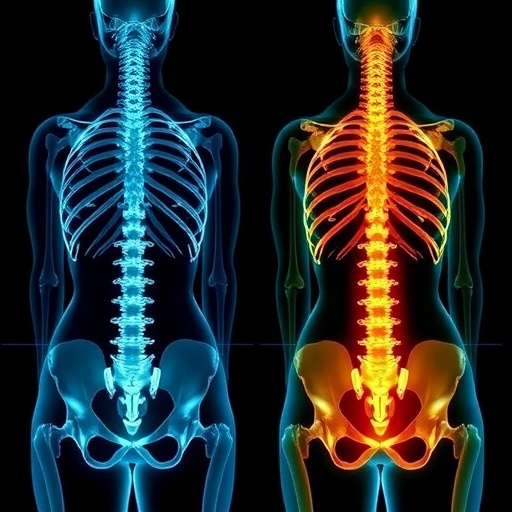Mount Sinai Researchers Uncover Critical Sex-Based Pelvic Variations Influencing Spinal Fixation Techniques
In a groundbreaking study published in Spine Deformity, the Mount Sinai Health System has revealed pivotal sex-based anatomical differences in pelvic morphology that profoundly impact the placement of spinal hardware during adult spinal deformity surgeries. This research elucidates how the divergent pelvic structures in men and women affect S2 alar-iliac (S2AI) screw positioning and lumbosacral rod alignment, highlighting the necessity for personalized surgical strategies tailored to each patient’s unique anatomy.
The pelvis, serving as a cornerstone for spinal fixation, exhibits significant morphological variation between sexes, historically acknowledged but rarely quantified with surgical precision. The latest insights from Mount Sinai demonstrate that men typically possess a narrower pelvic anatomy, resulting in a more medial starting position for S2AI screws. This subtle anatomical nuance drives clinically relevant challenges in achieving optimal rod alignment, a crucial factor for mechanical integrity and postoperative outcomes in spinal fusion procedures.
Technically, S2AI screws anchor the spinal construct to the pelvis, providing enhanced stability across the lumbosacral junction. Misalignment here can precipitate complications ranging from hardware failure to increased surgical times due to difficulties in rod contouring and fitting. The Mount Sinai team’s retrospective cohort analysis, comprising 185 cases from a single institution and involving multiple experienced surgeons, meticulously assessed postoperative radiographs and computed tomography scans to quantify these sex-related discrepancies.
Data revealed that male patients exhibited a significantly reduced distance between the posterior superior iliac spines (PSIS), averaging 7.1 cm compared to 8.1 cm in females. This constricted pelvic anatomy in men prompted a medialized screw entry point, which consequently forced rods to converge medially rather than maintain the ideal parallel orientation. Such malalignment necessitates enhanced rod bending intraoperatively, potentially compromising construct biomechanics and prolonging operative duration.
Further compounding these findings, the angular deviation of implant rods distally was markedly different between sexes. In males, rods showed an average convergence of −12.3 degrees, while females exhibited a divergence of +7.6 degrees, underscoring a pronounced divergence in spinal hardware alignment correlated with pelvic morphology. This novel quantification bridges a critical knowledge gap in spinal surgery, providing objective metrics to guide preoperative planning.
Clinically, these revelations bear profound implications. Surgeons must now anticipate sex-specific anatomical challenges when strategizing screw trajectories and fixation methods. The study advocates incorporating advanced intraoperative technologies such as navigation and robotics to mitigate alignment obstacles and reduce the need for excessive rod contouring. These adaptations promise to streamline complex procedures, decrease hardware-related complications, and ultimately enhance patient outcomes.
Mount Sinai’s research team underscores the study’s uniqueness, marking the first comprehensive effort to systematically characterize sex-based pelvic influences on S2AI screw placement and lumbosacral rod alignment within an adult deformity population. This pioneering work sets a critical precedent for future investigations, including biomechanical modeling and prospective clinical trials aimed at validating personalized surgical approaches.
The implications extend beyond technical refinements. In the era of precision medicine, understanding intrinsic anatomical variations enables the formulation of individualized surgical roadmaps, optimizing construct stability and patient recovery trajectories. This tailored approach exemplifies a paradigm shift toward integrating anatomical nuances with technological advancements in spine surgery.
Looking forward, the Mount Sinai researchers emphasize the need to evaluate whether these anatomical and biomechanical distinctions translate into measurable variations in long-term clinical outcomes such as implant longevity, rates of pseudarthrosis, and patient-reported quality of life indices. Such insights could revolutionize criteria for surgical candidacy and postoperative care algorithms.
Dr. James D. Lin, MD, MS, the study’s senior author, highlights, “Recognizing the anatomical diversity that underlies male and female pelvises compels us to rethink standardized approaches in spinal fixation. Our findings confirm that sex-specific strategies are not merely beneficial but necessary to elevate surgical precision and efficacy.” He further acknowledges contributions from Mount Sinai’s dedicated trainees, whose involvement was pivotal to this impactful discovery.
Mount Sinai Health System continues to be at the forefront of innovative healthcare solutions, marrying cutting-edge research with clinical excellence. This study exemplifies the institution’s commitment to advancing surgical science and enhancing individualized patient care, reinforcing Mount Sinai’s position as a leader in spinal deformity treatment.
As spinal surgery evolves, integrating comprehensive anatomical assessments with evolving technology will be essential. The insights derived from this seminal study provide a concrete foundation for transforming surgical paradigms, emphasizing the critical role of sex-specific pelvic anatomy in shaping successful spine surgery outcomes.
Subject of Research: Impact of sex-based pelvic anatomical differences on S2 alar-iliac screw positioning and lumbosacral rod alignment in adult spinal deformity surgery.
Article Title: Impact of sex on S2-alar-iliac pelvic screw position and lumbosacral rod alignment in adult spine deformity.
Web References: Spine Deformity Journal Article
Keywords: Orthopedics, Spine Surgery, Pelvic Anatomy, Sex Differences, S2 Alar-Iliac Screws, Spinal Deformity, Rod Alignment, Surgical Planning, Biomechanics, Personalized Medicine, Spinal Fusion, Adult Spine Surgery




